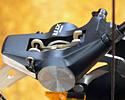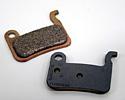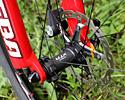First Impressions: Shimano XTR M970, July 25, 2006, part 2
Falling (literally) for Shimano's new group
James Huang continues his first impressions of Shimano's
latest mountain bike component group. Part
1 is here.
Brakes
Just about every component
Photo ©: James Huang

|
Shimano opens up and fights back
What the new XTR shows about Shimano
Let's get one thing straight right now: Shimano is a huge
company in bike industry terms. Consider these facts: Shimano operates
30 bases in 22 countries, and 14 factories churn out parts across
9 countries. Projected net sales and profits for 2006 are roughly
US$1.5B and US$150M, respectively, and Shimano employs over 7000
people worldwide, including nearly 1000 in Osaka along. By comparison,
SRAM, no small player in its own right, puts food on the table for
about 2000 worldwide.
With those kinds of numbers, it stands to reason that Shimano can
pretty much do whatever it wants and let the rest of the industry
adapt as necessary in response. Historically, that's basically what
it's done, at least in terms of product development. Shimano has
fostered a reputation for itself for conducting nearly the whole
of its development work behind tightly closed doors, only to reveal
the finished product when it feels ready to present it to the world.
Its elusive Skunkworks division is renowned for its ability to keep
the lid on products that have yet to be officially introduced, and
even in the internet age, spy photos and information about upcoming
componentry are rare and usually highly coveted.
For the most part, this "Surprise! Here's what we've been secretly
working on for the past few years; you'd better like it" style of
product R&D has worked well, yielding such innovations as the SPD
off-road clipless pedal and the STI integrated road shifter/brake
lever. Sales and profits have fallen off within the last couple
of years, though, and while it's anyone's guess as to the true cause,
it can't be ignored that the dates roughly coincide with Shimano's
introduction of its Dual Control style of mountain bike shifters
with the last generation of XTR along with the concurrent introduction
of SRAM's triggers. Times aren't exactly dire at the house of Shimano,
but certainly it raises a few eyebrows.
"Engineered for the way you ride"
The logo on the new XTR packaging is quite descriptive. Shimano
officials recognized early on that something was amiss in their
MTB product lineups and that, perhaps, Shimano was falling a bit
out of touch with its audience. In response, Shimano marketing and
engineering employees were sent out into various corners of the
cycling world early on in the development of M970. Their mission
was to find out not only what was wrong, but what needed to be done.
In contrast to its secretive reputation, Shimano caught innumerable
shop employees off guard when representatives showed up for shop
rides; locals discovered Shimano employees inhabiting their favorite
trails. Over and over, the phrase was repeated: "What the hell are
you doing here?"
According to Shimano, everything it learned from its field visits
has been incorporated into the new XTR group. Although XTR is still
a premier cross-country group, there is heaps more real world applicability
here that must have been directly linked to its research findings.
XTR's target user has both changed and broadened and so has the
hardware in response. The new group boasts no fewer than two wholly
different styles of shifters (plus hydraulic and mechanical brake
flavors), two types of rear derailleurs in various cage lengths,
both rim and disc brakes, and four disc brake rotor sizes. About
the only component that isn't broadly applicable to a wide range
of off-road usage is the new wheelset, which is admittedly XC-specific.
Shimano is still Shimano
XTR may signal a change of heart in terms of development, but Shimano
is still Shimano. For example, during an unscheduled elevator trip
down to street level to try out some trick commuter hardware, we
made an unexpected stop at an intermediate floor and the doors opened
up to a waiting Shimano engineer with a development mule in hand.
The doors were shut as quickly as they opened, followed by a terse
"Pretend you didn't see that." Similarly, no cameras of any sort
were allowed during our factory tour. As Kozo Shimano, head of Shimano
American Corporation, put it, "The trick isn't making something
that's really cool that works, it's making a million of these things
that's really cool and really works and they all work the same;
that's the tough thing."
So all is not open and warm and fuzzy at Shimano, but it's a refreshing
change nonetheless. Regardless, for all of you who have been speaking
up but thought your opinions were falling on deaf ears, rest assured
that Shimano is listening. Personally, I'd like to see more of the
same, but M970 XTR is a good example of what Shimano is capable
of when pointed in the right direction. Kampai!
|
Hoo-wee… there was definitely plenty of brake testing done on our overseas
journey, including a number of extended applications that served as a
suitably torturous brake fade experiment. The biggest change here is the
overall feel of the new system. The brake lever's revised pivot location
produces a shorter lever arm and leaves the brakes feeling much less 'weird',
particularly as the shifter pod is no longer an integral part of the brake
lever motion in Dual Control garb. As is now Shimano tradition, the brake
levers also have a very ergonomic shape with a pronounced "hook" and pleasantly
broad blade. A blasted finish on the blade itself also adds a measurable
amount of grip, especially when wet. In use, the new brakes feel absolutely
fantastic with a smoother lever action, more positive-feeling engagement
point, and modulation that is arguably second-to-none.
Shimano increases performance
Photo ©: James Huang

|
I don't know if the new radial master cylinder or the more direct fluid
path should be credited here, but regardless, they work quite well. Brake
fade was virtually nonexistent on the Kumano trail, even on super long
downhills with the brakes firmly clamped hard and long enough for the
rotors to audibly protest with a cacophony of pinging and tinging at the
bottom. If I could ask for anything, it'd be for just a bit more power,
especially given our use of sintered metallic pads during our trip. The
new XTR brakes are still quite powerful, but it seems like I've used a
handful of brakes with a bit more bite, particularly when trying to dump
a lot of momentum at high speed. As previously reported, though, rotor
sizes up to 203mm in diameter will be available and a 180mm front rotor
would almost certainly cure my woes.
Wheels
Not even the rotor
Photo ©: James Huang

|
The new XTR wheels are quite possibly the gem of the whole component
group. Shimano's engineers managed to lop roughly 200g off of last year's
version, and added a stiffer scandium-enhanced rim and a titanium freehub
body that engages 125 percent faster than before (alas, Shimano says it
can't be retrofitted to other XTR hubs or wheels). UST-compatibility is
retained, although the rim could use a deeper center channel to assist
in tire installation. Mounting my set of Schwalbe tubeless tires by hand
was next-to-impossible as compared to my other Mavic or Bontrager UST-compatible
test rims, but inflating the tires using a floor pump was pleasantly easy.
The new wheels exhibit a particularly snappy feel on the trail that should
be ridden firsthand to completely understand. In spite of their bantamweight
1525g, the torsional and lateral rigidity of the wheels was outstanding
with near-instant pedal response. The new freehub body is a huge improvement
over the relatively sluggish standard Shimano system and is particularly
welcome in stutter-pedal situations or when attempting to restart on climbs.
In spite of the rough terrain, both wheels remained arrow-straight.
Leaving Japan only slightly battered and bruised
Our motley crew
Photo ©: James Huang

|
It's doubtful that M970 will have quite the same impact as M950 did back
in the mid-90's, but Shimano has still managed to step to the plate with
an impressive package. XTR continues to carry Shimano's typically high
levels of fit, finish and precision and the new group is roughly 400g
lighter in total (when wheels are included) while improving on the function
and offering a wealth of user options. The bold new design looks better
in person than in pictures, and the rich double-anodized, machined, and
laser-etched combination finish is admittedly complicated and expensive,
but super pimpy.
Never fear, XTR is still a premier cross-country racing group, but its
versatility has been expanded to include 'normal' folk who just want to
ride around with nice stuff (and have the income to afford it) as well
as some mildly hardcore applications. It'll remain to be seen how the
new XTR kit will be received by the public, but personally, I'm definitely
looking forward to putting some more time in on the stuff.
Photography
For a thumbnail gallery of these images, click here
Images by
James Huang/Cyclingnews
-
I think this goes
somewhere around here…
-
XTR parts
go through a number of finishing steps before the final result is achieved. Keep in mind that this sequence doesn’t even include any forming steps.
-
The new XTR group
is serious kit with serious looks and function to match.
-
The new rear derailleur
gets wider and stiffer links plus a bold new industrial look.
-
M970’s new chainrings
are very rigid to provide excellent shifting under load. Though it will likely be taken for granted, it was apparently no small feat to get the carbon finish of the middle chainring to visually match the rest of the anodizing on the rest of the gear.
-
Not even the rotor
was spared from the milling machine. Check out the edges of the disc brake rotor spider. The new wheel retains the use of straight-pull stainless steel spokes.
-
A supplementary thumb lever
remains on M970, but it’s even more of a vestigial nub than before as I didn’t feel the need to use it even once during our rides. Cable changes on the Dual Control setup are now far easier than before, with no tiny screws to lose.
-
Just about every component
in the new M970 XTR kit is not only anodized at least twice, but also machined and laser-etched to impart the unique finish.
-
Our test components
were all etched “PROTOTYPE”, but any planned changes between what we rode and production bits were to be purely cosmetic.
-
Shimano increases performance
and saves some titanium from the recycling bin by using center cutouts from its titanium cassette cogs as backing material for the new XTR metallic disc brake pads.
-
Nope, I haven’t become
one of Shimano’s coveted Skunkworks riders, but I at least have the sticker…
-
Our fleet of XTR-equipped bikes
at rest on a very rare smooth section of the Kumano trail…
-
…the rest of it
was more like this, and this was a relatively tame section.
-
Our motley crew
- ready to ride, and sweating our asses off. Joe Murray is deep in thought, while Mike Ferrentino puts on his best “tough man” pose.
-
Lots of rain in Japan
equals lots of greenery as we put the new XTR through its paces.
|






